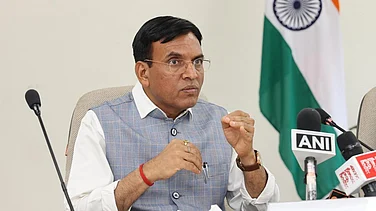Finance Minister Nirmala Sitharaman, in the post-budget press conference, said that the budget has been able to balance growth considerations through enormous boost to capital investment and infrastructure spending, addressing concerns of MSME sector, and individual taxpayers’ needs. The budget increased capital expenditure (capex) target by 33 per cent to Rs 10 lakh crore for financial year 2023-24. Government’s capex would account for 3.3 per cent of India’s gross domestic product, up from 2.7 per cent in 2022-23. For the ongoing financial year, capex target was set at Rs 7.5 lakh crore and included Rs 1 lakh crore as a capex-only, interest-free loan to states for 50 years.
Finance Secretary TV Somanathan said that Centre’s capex is expected to cross budgeted levels but states may not reach the Rs 1 lakh crore tied to specific reforms. “The central capital expenditure is going to exceed the budget estimates. State capital expenditure is not expected to reach the Rs 1 lakh crore figure because some portions of the state capital investment scheme have reform conditions. So, some states have not been able to meet some of the conditions. Therefore, 76 percent of the state capital expenditure scheme is likely to be met,” Somanathan said.
The finance secretary noted that Indian Railways and highways have adequate projects running to absorb the additional capital expenditure. He said that though states’ capex would remain a challenge, they are gearing up. “The two years of this experiment has helped them to improve their spending capacity and we are also seeing an up-tick in the second half of this year on the state capital expenditure. So, I am reasonably confident that the states will absorb the Rs 1,30,000 crore that has been provided. The other big item on the Centre’s side is petroleum capital expenditure which is for retro-fitting of refineries to meet emission standards and pollution standards and partly for augmenting our strategic reserves. So, I am quite confident that we will meet the expenditure targets,” Somanathan said.
The budget pegs total receipts other than borrowings at Rs 27.2 lakh crore and net tax receipts are estimated at Rs 23.3 lakh crore. In 2022-23 revised estimate, total receipts other than borrowings is Rs 24.3 lakh crore, of which the net tax receipts are Rs 20.9 lakh crore.
“Gross Tax Revenue (GTR) is projected to grow at 10.4 per cent in FY 2023-24 over FY 2022-23. Both, the direct and indirect tax receipts are individually estimated to grow at 10.5 per cent and 10.4 per cent, respectively,” the fiscal policy statement said.
Somanathan said that the revenue estimates in the budget do not assume buoyancy greater than 1 for the coming financial year. “Gross taxes are expected to grow by the same 10.5 percent by which we have estimated the GDP to growth, which is slightly lower than the figure implied by the Economic Survey. If the experience of this year is repeated next year, then it may in fact be more than 1. But we have taken a conservative assumption. Many of our expenditure increases are on discretionary spends. We have kept a very tight lid on the irreducible types of expenditure. And therefore, there is room in the budget both on the revenue and on the expenditure side for us to reach that fiscal deficit target by 2025-26.”
On the slew of income tax measures announced in the budget, Finance Minister (FM) Nirmala Sitharaman stated that the new tax regime was more attractive as it offered better rebate. “New tax regime is attractive. Those who want to remain in old can still remain there. But the new one is attractive because it gives a greater rebate. It also provides for simplified and smaller slabs, lower rates of taxation and also slabs which are nicely broken down,” the FM said.
Union Budget 2023-24 announced that income tax rebate limit for an individual taxpayer has been hiked to Rs 7 lakh from the present Rs 5 lakh. Under the old tax regime, those with income up to Rs 5 lakh also could avail benefits of up to Rs 7 lakh by virtue of the Rs 1.5 lakh available as deduction under Section 80C and Standard Deduction of Rs 50,000. The minister said that while the new tax regime would become the default regime but those who choose the older regime can still opt for it.
With the changes announced this time, the new taxation regime has greater incentives and attractions so that people can unhesitatingly move from the old to the new, but the government is not forcing anyone to make a shift.






























